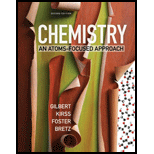
To calculate:
The
Answer to Problem 16.123QA
Solution:
a) pH at the equivalence point of titration of formic acid is 8.23.
b) pH at the equivalence point of titration of boric acid is 10.98.
c) Considering the difference in the pH values at equivalence point, the same indicator should not be used for both titrations.
Explanation of Solution
1) Concept:
We are asked to find the =
Formic acid is a weak organic monoprotic acid with the
Boric acid is a weak monobasic acid. For the titration between boric acid and
2) Formulae:
i)
ii)
iii)
iv)
v)
vi)
3) Given:
i) Volume of formic acid
ii) Molarity of formic acid
iii)
iv) Volume of boric acid
v) Molarity of boric acid
vi) Molarity of
vii)
4) Calculations:
a) Calculating the
Calculating moles of formic acid using given molarity and volume:
At the equivalence point, moles of formic acid and sodium hydroxide are equal. Thus, moles of
Calculating the volume of
Total volume of solution is
At the equivalence point, moles of sodium formate formed are
At the equivalence point, salt sodium formate
Creating an ICE table for the dissociation reaction of sodium formate as
| Initial | |||
| Change | |||
| Equilibrium | |||
Writing the
The
Indicator changes color over a
b) Calculating the
Calculating moles of boric acid using given molarity and volume. Here, we assume that the volume of boric acid is
At the equivalence point, moles of formic acid and sodium hydroxide are equal. Thus, moles of
Calculating volume of
Total volume of solution is
During the reaction of boric acid and sodium hydroxide, sodium borate will be produced. At the equivalence point, moles of sodium borate formed are
At the equivalence point, salt sodium borate
Creating an RICE table for the dissociation reaction of sodium borate as:
| Initial | |||
| Change | |||
| Equilibrium | |||
Writing the
The
Indicator changes color over a
Conclusion:
Indicator changes color over a
Want to see more full solutions like this?
Chapter 16 Solutions
CHEM:ATOM FOC 2E CL (TEXT)
- Beer’s Law is A = εbc, where A is absorbance, ε is the molar absorptivity (which is specific to the compound and wavelength in the measurement), and c is concentration. The absorbance of a 2.31 × 10-5 M solution of a compound is 0.822 at a wavelength of 266 nm in a 1.00-cm cell. Calculate the molar absorptivity at 266 nm.arrow_forwardHow to calculate % of unknown solution using line of best fit y=0.1227x + 0.0292 (y=2.244)arrow_forwardGiven a 1,3-dicarbonyl compound, state the (condensed) formula of the compound obtaineda) if I add hydroxylamine (NH2OH) to give an isooxazole.b) if I add thiosemicarbazide (NH2-CO-NH-NH2) to give an isothiazole.arrow_forward
- Complete the following acid-base reactions and predict the direction of equilibrium for each. Justify your prediction by citing pK values for the acid and conjugate acid in each equilibrium. (a) (b) NHs (c) O₂N NH NH OH H₁PO₁arrow_forward23.34 Show how to convert each starting material into isobutylamine in good yield. ཅ ནད ཀྱི (b) Br OEt (c) (d) (e) (f) Harrow_forwardPlease help me Please use https://app.molview.com/ to draw this. I tried, but I couldn't figure out how to do it.arrow_forward
- Propose a synthesis of 1-butanamine from the following: (a) a chloroalkane of three carbons (b) a chloroalkane of four carbonsarrow_forwardSelect the stronger base from each pair of compounds. (a) H₂CNH₂ or EtzN (b) CI or NH2 NH2 (c) .Q or EtzN (d) or (e) N or (f) H or Harrow_forward4. Provide a clear arrow-pushing mechanism for each of the following reactions. Do not skip proton transfers, do not combine steps, and make sure your arrows are clear enough to be interpreted without ambiguity. a. 2. 1. LDA 3. H3O+ HOarrow_forward
- b. H3C CH3 H3O+ ✓ H OHarrow_forward2. Provide reagents/conditions to accomplish the following syntheses. More than one step is required in some cases. a. CH3arrow_forwardIdentify and provide an explanation that distinguishes a qualitative and quantitative chemical analysis. Provide examples.arrow_forward
 ChemistryChemistryISBN:9781305957404Author:Steven S. Zumdahl, Susan A. Zumdahl, Donald J. DeCostePublisher:Cengage Learning
ChemistryChemistryISBN:9781305957404Author:Steven S. Zumdahl, Susan A. Zumdahl, Donald J. DeCostePublisher:Cengage Learning ChemistryChemistryISBN:9781259911156Author:Raymond Chang Dr., Jason Overby ProfessorPublisher:McGraw-Hill Education
ChemistryChemistryISBN:9781259911156Author:Raymond Chang Dr., Jason Overby ProfessorPublisher:McGraw-Hill Education Principles of Instrumental AnalysisChemistryISBN:9781305577213Author:Douglas A. Skoog, F. James Holler, Stanley R. CrouchPublisher:Cengage Learning
Principles of Instrumental AnalysisChemistryISBN:9781305577213Author:Douglas A. Skoog, F. James Holler, Stanley R. CrouchPublisher:Cengage Learning Organic ChemistryChemistryISBN:9780078021558Author:Janice Gorzynski Smith Dr.Publisher:McGraw-Hill Education
Organic ChemistryChemistryISBN:9780078021558Author:Janice Gorzynski Smith Dr.Publisher:McGraw-Hill Education Chemistry: Principles and ReactionsChemistryISBN:9781305079373Author:William L. Masterton, Cecile N. HurleyPublisher:Cengage Learning
Chemistry: Principles and ReactionsChemistryISBN:9781305079373Author:William L. Masterton, Cecile N. HurleyPublisher:Cengage Learning Elementary Principles of Chemical Processes, Bind...ChemistryISBN:9781118431221Author:Richard M. Felder, Ronald W. Rousseau, Lisa G. BullardPublisher:WILEY
Elementary Principles of Chemical Processes, Bind...ChemistryISBN:9781118431221Author:Richard M. Felder, Ronald W. Rousseau, Lisa G. BullardPublisher:WILEY





